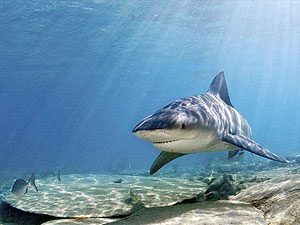The bull shark, Carcharhinus leucas, also known as Zambezi shark or unofficially known as Zambi in Africa and Nicaragua shark in Nicaragua, is a shark commonly found worldwide in warm, shallow waters along coasts and in rivers.


The bull shark, Carcharhinus leucas, also known as Zambezi shark or unofficially known as Zambi in Africa and Nicaragua shark in Nicaragua, is a shark commonly found worldwide in warm, shallow waters along coasts and in rivers.
The bull shark is well known for its unpredictable, often aggressive behavior. Since bull sharks often dwell in shallow waters, they may be more dangerous to humans than any other species of shark.
Bull sharks are aggressive, common, and usually live near high-population areas like tropical shorelines. They are not bothered by salty and freshwater, and even venture far inland via rivers and tributaries.
Due to these characteristics, many experts consider bull sharks to be the most dangerous sharks in the world. Historically, they are joined by their more famous cousins, great whites and tiger sharks, as the three species most likely to attack humans.
Bull sharks get their name from their short, blunt snout, as well as their aggressive nature and a tendency to head-butt their prey before attacking.
Bull sharks eat fish, other sharks, dolphins, rays, turtles, seabirds, molluscs, echinoderms, crustaceans, and virtually any other animal, potentially including humans. Bull sharks have been known to use the ‘bump-and-bite’ technique to attack their prey. Relatively calm bull sharks can suddenly become violent and begin to bump divers.
They are medium-sized sharks, with thick, stout bodies and long pectoral fins. They are gray on top and white below, and their fins have dark tips, particularly on young bull sharks.
They are found sailing the shallow, warm waters of all the world’s oceans. Fast, agile predators, they will eat almost anything they see, including fish, dolphins, and even other sharks. Humans are not, per se, on their menus.
However, they frequent the muddy waters of estuaries and bays, and often attack people unintentionally or out of curiosity.
Bull sharks currently are not threatened or endangered. However, they are fished widely for their meat, hides, and oils, and their numbers are likely shrinking. One study has found that their average lengths have declined significantly over the past few decades.
Bull sharks mate during late summer and early autumn, often in the salty water of river mouths. After gestation for 12 months, a bull shark may give birth to 4-10 live young.
They are viviparous. The young are about 70 cm (27.6 in) at birth and take 10 years to reach maturity.
Ends




